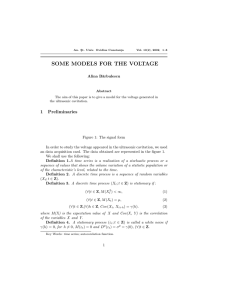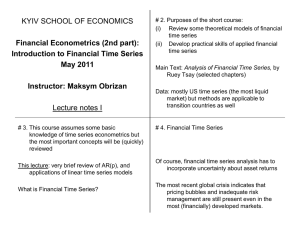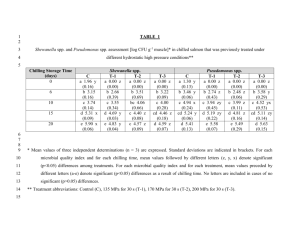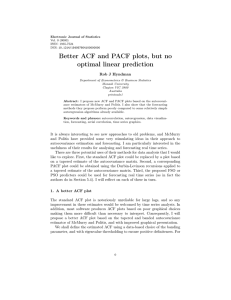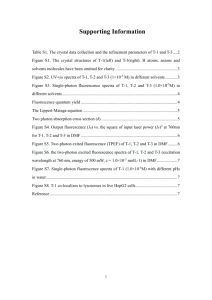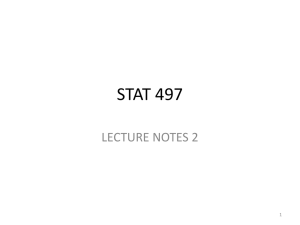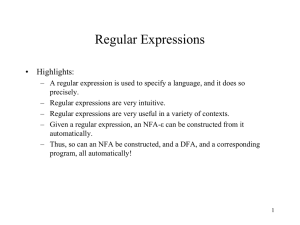Identifying ARIMA Mo..
advertisement
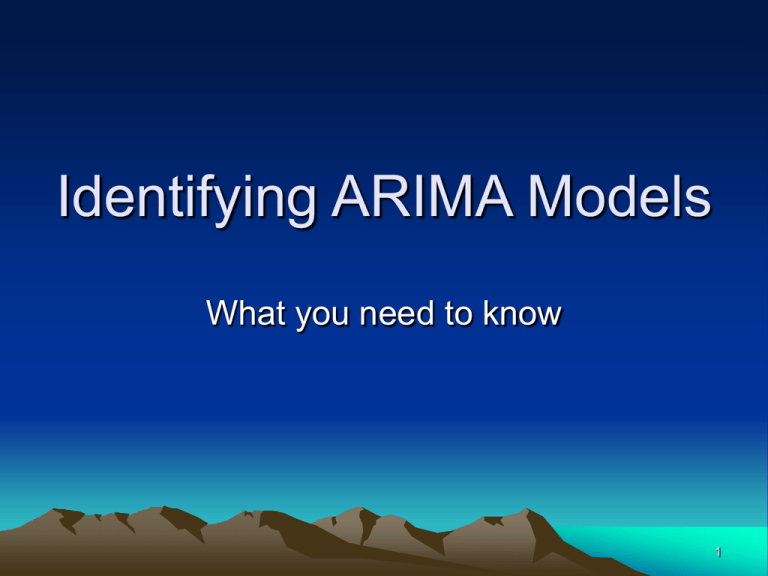
Identifying ARIMA Models
What you need to know
1
Autoregressive of the second order
• X(t) = b1 x(t-1) + b2 x(t-2) + wn(t)
• b2 is the partial regression coefficient
measuring the effect of x(t-2) on x(t)
holding x(t-1) constant
• Since x(t) is regressed on itself lagged, b2
can also be interpreted as a partial
autoregression coefficient of x(t) regressed
on itself lagged twice.
2
continued
• In one more step b2 can be defined as the
partial autocorrelation coefficient at lag 2,
b2 = pacf(2)
• Solving the yule-Walker equations:
• b2 = {acf(2) – [acf(1)]2 }/[1 – [acf(1)]2
• We know that if the process is
autoregressive of the first order, then
acf(2) = [acf(1)]2 and so b2 = 0
3
So now we are back to
autoregressive of the first oder
• x(t) = b x(t-1) + wn(t)
• There is only one regression coefficient, b,
so acf(1) = pacf(1) = b
4
In summary
• The partial autocorrelation function, pacf(u)
indicates the order of the autregressive process.
If only pacf(1) is significantly different from zero,
then the autoregressive process is of order one.
If the pacf(2) is significantly different from zero,
then the autoregressive process is of order two,
and so on.
• Thus we use the partial autocorrelation function
to specify the order of the autoregressive
process to be estimated
5
The autocorrelation function
• The autocorrelation function, acf(u) is used
to determine the order of the moving
average process
• If acf(1) is significantly different from zero
and there are no other significant
autocorrelations, then we specify a first
order MA process to be estimated
6
Cont.
• If there is a significant autocorrelation at
lag two and none at higher lags, then we
specify a second order moving average
process
7
Moving Average Process
• X(t) = wn(t) + a1wn(t-1) + a2wn(t-2) + a3wn(t-3)
• Taking expectations the mean function is zero,
Ex(t) = m(t) = o
• Multiplying by x(t-1) and taking expectations,
E[x(t)x(t-1)] =
• EX(t) = wn(t) + a1wn(t-1) + a2wn(t-2) + a3wn(t-3)
X(t-1) = wn(t-1) + a1wn(t-2) + a2wn(t-3) + a3wn(t4), γx,x (1) = [a1 + a1 a2 + a2 a3 ] σ2
8
Continuing
• The autocovariance at lag 2, γx,x (2) = E x(t) x(t-2)
• EX(t) = wn(t) + a1wn(t-1) + a2wn(t-2) + a3wn(t-3)
X(t-2) = wn(t-2) + a1wn(t-3) + a2wn(t-4) + a3wn(t-5), γx,x
(2) = [a2 + a1 a3 ] σ2
• The autocovariance at lag 3, γx,x (3) = E x(t) x(t-4)
• EX(t) = wn(t) + a1wn(t-1) + a2wn(t-2) + a3wn(t-3)
X(t-3) = wn(t-3) + a1wn(t-4) + a2wn(t-5) + a3wn(t-6), γx,x
(3) = [a3 ] σ2
• The autocovariance at lag 4 is zero, E x(t)x(t-4) = 0, so
the autocovariance function determines the order of
the MA process
9
Specifying ARMA Processes
• x(t) = A(z)/B(z)
• The autocovariance function divided by the variance,
i.e. the autocorrelation function, acf(u), indicates the
order of A(z) and the partial autocorrelation function,
pacf(u) indicates the order of B(z)
• In Eviews specify x(t) c ar(1) ar(2) ….ar(u) for a uth
order B(z) and include ma(1) ma(2) ….ma(u) for a uth
order A(z),
• i.e. X(t) c ar(1) ar(2) …ar(u) ma(1) ma(2) …ma(u)
10
Summary of Identification
•
•
•
•
•
•
•
Spreadsheet
Trace: Is it stationary?
Histogram: is it normal?
Correlogram: order of A(z) and B(z)
Unit root test: is it stationary?1111
Specification
estimation
11
ARMA Processes
• Identification
• Specification and Estimation
• Validation
– Significance of estimated parameters and DW
– Actual, fitted and residual
– Residual tests
• Correlogram: are they orthogonal? Also the
Breusch-Godfrey test for serial correlation
• Histogram; are they normal?
• Forecasting
12
Example: Capacity utilization mfg.
13
Spreadsheet
14
Histogram
60
Series: MCUMFN
Sample 1972:01 2010:03
Observations 459
50
40
30
20
10
Mean
Median
Maximum
Minimum
Std. Dev.
Skewness
Kurtosis
78.98322
79.30000
88.50000
65.20000
4.647918
-0.603442
3.051589
Jarque-Bera
Probability
27.90780
0.000001
0
66 68 70 72 74 76 78 80 82 84 86 88
15
Correlogram
16
Unit root test
17
Pre-Whiten
Gen dmcumfn =mcumfn – mcumfn(-1)
18
Spreadsheet
19
Trace
2
1
0
-1
-2
-3
-4
75
80
85
90
95
DMCUMFN
00
05
10
20
histogram
120
Series: DMCUMFN
Sample 1972:02 2010:03
Observations 458
100
80
60
40
20
Mean
Median
Maximum
Minimum
Std. Dev.
Skewness
Kurtosis
-0.023799
0.000000
1.800000
-3.900000
0.660698
-1.109196
7.351042
Jarque-Bera
Probability
455.1915
0.000000
0
-4
-3
-2
-1
0
1
2
21
Correlogram
22
Unit root test
23
Specification
Dmcumfn c ar(1) ar(2)
24
Estimation
25
Validation
2
0
4
-2
2
-4
0
-2
-4
75
80
85
Residual
90
95
Actual
00
05
10
Fitted
26
Correlogram of the residuals
27
Breusch-Godfrey Serial correlation test
28
Re-Specify
29
Estimation
30
Validation
2
0
4
-2
2
-4
0
-2
-4
75
80
85
Residual
90
95
Actual
00
05
10
Fitted
31
Correlogram of the Residuals
32
Breusch-Godfrey Serial correlation test
33
Histogram of the residuals
100
Series: Residuals
Sample 1972:05 2010:03
Observations 455
80
60
40
Mean
Median
Maximum
Minimum
Std. Dev.
Skewness
Kurtosis
8.09E-05
0.010460
2.669327
-2.954552
0.583609
-0.316126
6.875041
Jarque-Bera
Probability
292.2558
0.000000
20
0
-3
-2
-1
0
1
2
34
Forecasting: Procs. Workfile range
35
Forecasting: Equation
window.forecast
36
Forecasting
2.0
1.5
1.0
0.5
0.0
-0.5
-1.0
-1.5
10:04 10:05 10:06 10:07 10:08 10:09 10:10 10:11 10:12
DMCUMFNF
± 2 S.E.
37
Forecasting: Quick, show
38
Forecasting
39
Forecasting: show, view, graph-line
2
1
0
-1
-2
-3
00
01
02
03
04
DMCUMFN
FORECAST
05
06
07
08
09
10
+2*SEF
FORECAST-2*SEF
40
Reintegration
41
Forecasting mcumfn
42
Forecast mcumfn, quick, show
43
Forecasting mcumfn
84
80
76
72
68
64
00
01
02
03
04
MCUMFN
MCUMFNF
05
06
07
08
09
10
MCUMFNF+2*SEF
MCUMFNF-2*SEF
44
What can we learn from this forecast?
• If, in the next nine months, mcumfn grows
beyond the upper bound, this is new
information indicating a rebound in
manufacturing
• If, in the next nine months, mcumfn stays
within the upper and lower bounds, then
this means the recovery remains sluggish
• If mcumfn goes below the lower bound,
run for the hills!
45
